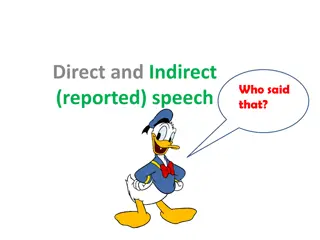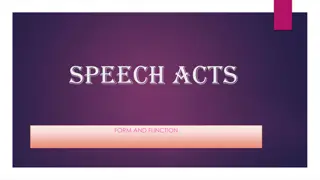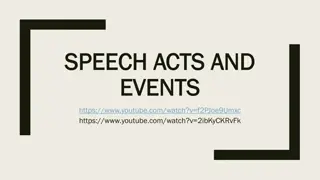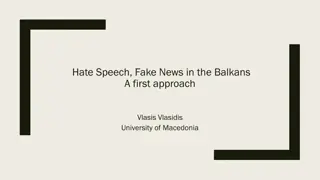Understanding Speech Act Strategies Used in Ginou Jisshusei and Tokutei Ginou
Communication strategies play a crucial role in conveying messages effectively. This study explores the speech act strategies employed by Ginou Jisshusei and Tokutei Ginou individuals, focusing on request expressions. Through a descriptive research method, the study aims to provide insight into the use of strategies in communication settings. Findings indicate that Indonesian workers predominantly utilize indirect speech acts requiring approval from their supervisors. The study also utilizes discourse completion tests for data collection.
Download Presentation

Please find below an Image/Link to download the presentation.
The content on the website is provided AS IS for your information and personal use only. It may not be sold, licensed, or shared on other websites without obtaining consent from the author. Download presentation by click this link. If you encounter any issues during the download, it is possible that the publisher has removed the file from their server.
E N D
Presentation Transcript
REQUEST SPEECH ACT STRATEGY USED BY GINOU JISSHUSEI AND TOKUTEI GINOU No. Abstract: ABS-ICOLLITE-23130 Ririn Apriliyanti Yowanda1,*Juju Juangsih2,Susi Widianti3 Indonesia University of Education
INTRODUCTION A phrase is someone's way of expressing a message that is conveyed to the other person when communicating. To get your message across, you need to have the right strategy so that your message gets through to the people you're speaking to. strategies depending on their intended use. Communication strategies are also necessary to ensure that the message being conveyed is properly conveyed to the speaking partner, especially when communicating with a speaking partner who speaks a language other than their mother tongue. Listiyorini (2009, p. 7) added that using correct speech strategies is necessary to achieve certain goals in communication. Speech strategies can be applied by choosing a particular speech format considering the socio-cultural background behind it. A strategy is a method or step someone takes to achieve a goal, and there are different types of
LITERATURE REVIEW Expression of Request (Irai) Pragmatics Speech acts Speech Action Strategy for Requests Nakamizu (1992) Huang (2007) Yule (1996) Shiro (in Susanti, 2008) Leech (1983) Blum-kulka & Olshtain (1984) Searle (1696) Giichi et all. (2002) R hlemann (2018)
METHOD The researcher chose to use the descriptive method which is a research method that tries to describe phenomena or events that are happening in the present. Creswell (1994) describes a descriptive research method of gathering information about current conditions. Then furthermore, Creswell (2014) explains that the purpose of the descriptive method is to find detailed explanations and descriptions of the object of research in a systematic manner. researcher aims to describe the actual phenomena that exist in the Ginou Jisshuusei and Tokutei ginou environments in using speech acts of requests that focus on usage strategies. By using this descriptive method it is expected to be able to answer all the problems contained in this study. Because the data generated will be in the form of a series of sentences, the researcher chose to use a qualitative research design. It can be concluded that by choosing a descriptive method and a qualitative research design, the theory put forward by Bebee and Cummings (in Chang, 2006, p. 4) which states that the DCT or discourse completion test is a written questionnaire (test) in which a situation is given explaining the background, social distance between participants, and social status. each, then contains a brief dialogue and there is a blank section for respondents to provide feedback. In this study, researchers used DCT as an instrument in data collection. This is motivated by the
FINDING AND DISCUSSION Graphic Application Expression Strategy By All Respondents The request expression strategy used by interlocutors (Indonesian workers) to their speech partners (supervisors) 36.1% is spoken indirectly (a request requires approval from the speech partner), this is marked by the use of endings including: V+ (( V+ te moii desuka), V+ moyoroshii deshouka), V+ (V+ te itadake masenka), V+ (V+sa sete itadake nai deshouka), the respondent as subordinates are very careful about expressing their requests to their speech partners (bosses), especially in Japanese culture upholds the relationships made which are directly related to oneself in society (Chiaki, 2007). 40 36.1 35 30 26.7 (V+ te 25 Dalam % 20 17.8 15 9.8 10 4.1 5 2.6 1.3 0.4 0.4 0.4 0 0 0
The same thing is also found in the expressions spoken to friends and subordinates as his speech partners. By looking at the results of the graph (figure 1), the percentage of expressing requests to Indonesian workers tends to indirectly reveal it with the results of 26.7% to friends or peers and 17.8% with subordinates as speech partners, more speakers ask for approval from related partners previously disclosed application. According to Blum-Kulka & Olshtain (in Andari et al., 2018, p. 261) states that choosing a request strategy can minimize coercion on the speech partner. From the results of the questionnaire that was conducted, Indonesian workers expressed their requests directly ( / chokusetsu irai hyougen) and indirectly ( / kansetsu hyougen), expressed their wishes and invited them.
CONCLUSION The request speech act strategy based on data from 16 respondents found three types of request strategies used by Technical Apprentices/ Tokutei ginou and Skilled Workers/ Ginou Jisshuusei in communicating with speech partners (Japanese people) who have close or not close relationships and different levels position in the work environment. The strategies used are direct, indirect and direct strategies. The direct request strategy has one sub-strategy, namely imperative. Meanwhile, the indirect request strategy has two sub-strategies, namely asking the speech partner's willingness and conveying the speaker's wishes or needs to the speech partner. And the request strategy expressed by inviting. workers with specific skills/ Tokutei ginou who are in preparation for or will go to work in Japan as initial provision. This study discusses the speech act strategy of requests used by Ginou Jisshusei and Tokutei ginou when communicating verbally with their speech partners in the work environment. Because of the differences that Indonesian workers have in terms of differences language, it is sometimes difficult for the speech partners to understand the meaning of the requests made by the interlocutors. This research is intended for instructors who specifically teach technical interns/ Ginou Jisshusei and
REFERENCES Abdullah, A. (2018). LINGUISTIK UMUM (Novietha I. Sallama, Ed.; Revisi). Penerbit Erlangga. http://repository.uinjkt.ac.id/dspace/handle/123456789/48974 Andari, P. D. A., Hermawan, G. S., & Suartini, N. N. (2018). ANALISIS TINDAK TUTUR PERMINTAAN PADA DRAMA RICH MAN POOR WOMAN. Jurnal Pendidikan Bahasa Jepang Undiksha, 4(3), 259 269. https://doi.org/https://doi.org/10.23887/jpbj.v4i3.13327 Astami, T. S. (2015). Strategi Permintaan dalam Bahasa Jepang. HUMANIORA , 6(1), 51 58. https://doi.org/https://doi.org/10.21512/humaniora.v6i1.3297 Blum-kulka, S., & Olshtain, E. (1984). Requests and apologies: A cross-cultural study of speech act realization patterns (CCSARP). Applied Linguistics, 5(3), 196 213. https://doi.org/10.1093/applin/5.3.196 Chang, Y.-F. (2006). An Inquiry into Pragmatic Data Collection Methods. Korea Association of Teachers of English (KATE) International Conference. https://eric.ed.gov/?id=ED508832 Chiaki, T. (2007). - . , 5, 157 172. http://hdl.handle.net/2298/3294 Creswell, J. W. (1994). Research design: Qualitative & quantitative approaches. In Research design: Qualitative & quantitative approaches. Sage Publications, Inc. Creswell, J. W. (2014). Research design : qualitative, quantitative, and mixed methods approaches (4th ed). SAGE Publication, Inc. Giichi, K., Hiroshi, K., & Megumi, S. (2002). . , 1, 21 30. https://cir.nii.ac.jp/crid/1050282677466536064 Haugh, M., K d r, D. Z., & Terkourafi, M. (2021). Introduction: directions in sociopragmatics. In The Cambridge handbook of sociopragmatics (pp. 1 12). Cambridge University Press. https://doi.org/https://doi.org/10.1017/9781108954105.001 Huang, Y. (2007). Pragmatics (K. Brown, E. V Clark, A. McMahon, J. Miller, & L. Milroy, Eds.). Oxford University Press Inc. Leech, G. (1983). Principles of Pragmatics (First published). Longman Group Limited. z-lib.org
THANK YOU! Follow us @...


![Prevention and Combating of Hate Crimes and Hate Speech Bill [B.9B.2018]](/thumb/60513/prevention-and-combating-of-hate-crimes-and-hate-speech-bill-b-9b-2018.jpg)




















